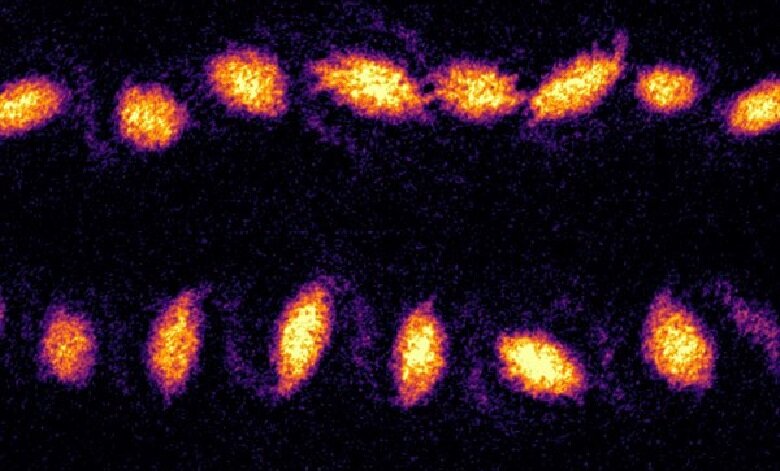The world we experience is governed by classical physics. How we move, where we are, and how fast we’re going are all determined by the classical assumption that we can only exist in one place at any one moment in time.
But in the quantum world, the behavior of individual atoms is governed by the eerie principle that a particle’s location is a probability. An atom, for instance, has a certain chance of being in one location and another chance of being at another location, at the same exact time.
When particles interact, purely as a consequence of these quantum effects, a host of odd phenomena should ensue. But observing such purely quantum mechanical behavior of interacting particles amid the overwhelming noise of the classical world is a tricky undertaking.
Now, MIT physicists have observed a stunning demonstration of classic physics giving way to quantum behavior, manipulating a fluid of ultra-cold sodium atoms into a distinct tornado-like formation.
In a study published today in Nature, the MIT team has rapidly rotated a quantum fluid of ultracold atoms. They watched as the initially round cloud of atoms first deformed into a thin, needle-like structure. Then, at the point when classical effects should be suppressed, leaving solely interactions and quantum laws to dominate the atoms’ behavior, the needle spontaneously broke into a crystalline pattern, resembling a string of miniature, quantum tornadoes.
“It’s a breakthrough to be able to see these quantum effects directly,” says MIT physicist Martin Zwierlein.
The team trapped and spun a cloud of around 1 million sodium atoms using lasers and electromagnets. In previous research physicists demonstrated this would spin the cloud into a long needle-like structure, a Bose-Einstein condensate, where the gas starts to behave like a single entity with shared properties.
“In a classical fluid, like cigarette smoke, it would just keep getting thinner,” says Zwierlein. “But in the quantum world, a fluid reaches a limit to how thin it can get.”
In the new study, MIT physicist Biswaroop Mukherjee and colleagues pushed beyond this stage, capturing a series of absorption images that reveal what happens after atoms’ have switched from being predominantly governed by classical to quantum physics.
The image below highlights the densities of ultra-cold atoms across microseconds.

The atom cloud evolved from the needle-like condensate (left), passed through snake-shaped instability (center), and formed miniscule tornadoes (right).
There are even tiny dark spots between the neighboring crystals (see the ‘x’ marks below) where vortexes of counterflow occur – just as we see in complex weather systems (think of the roiling adjoining storms on Jupiter).

“Here, we have quantum weather: The fluid, just from its quantum instabilities, fragments into this crystalline structure of smaller clouds and vortices,” explains Zwierlein.
“This evolution connects to the idea of how a butterfly in China can create a storm [in the US], due to instabilities that set off turbulence. Even in classical physics, this gives rise to intriguing pattern formation, like clouds wrapping around the Earth in beautiful spiral motions. And now we can study this in the quantum world.”
The team controlled the system so nothing else was exerting a force on the atomic subjects. This meant only the interactions of the particles themselves and their rotation was at play. Their resulting behavior displayed supersolid properties, somewhat like what electrons produce in the form of Wigner crystals.
While traditional crystal solids are usually composed of atoms arranged in a stationary, repeating grid structure, these structures continue to fluctuate but remain within a definable pattern – like a liquid pretending to be a solid by holding and flowing through a fixed shape.
The team essentially made the atoms to behave like they’re electrons in a magnetic field. Using atoms in this way makes the resulting quantum phenomena easier to both manipulate and observe – opening the way for even more discoveries about this mind-bending world.
“We can visualize what individual atoms are doing, and see if they obey the same quantum mechanical physics,” says Zwierlein.
Sources:

